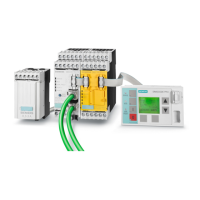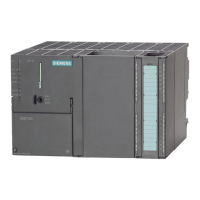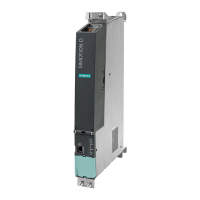Parameters
4.7 Standard functions
SIMOCODE pro - Parameterize
Operating Manual, 04/2017, A5E40507630002A/RS-AA/001
223
Description of the settings of the DIP switches on the DM-F Local
Table 4- 79 Description of the settings of the DIP switches, DM-F Local
DIP switches (DM-F Local)
With/without cross-circuit detection Cross-circuit detection is only possible with floating sensors. The
sensors must be connected between T1 - Y12, Y33 and T2 - Y22,
Y34. The device anticipates the T1 terminal test signal at the
terminals Y12 and Y33, and the T2 terminal test signal at the
terminals Y22 and Y34. The device detects a sensor fault if the signal
at the Y12, Y33 or the Y22, Y34 terminals is not identical to the test
signals T1, T2.
Cross-circuit detection must be deactivated if electronic sensors such
as light arrays or laser scanners are connected. The DM-F Local now
no longer monitors the sensor inputs for cross-circuit detection.
Usually, the outputs of safety sensors (OSSD) are already monitored
for cross-circuits in the sensor itself.
If "Without cross-circuit detection" is set on the device, the test
outputs T1, T2 are deactivated and may no longer be connected. At
the Y12, Y22, Y33, and Y34 inputs, the DM-F LOCAL expects a
+24 V DC signal from the same current source as the one from which
the device receives its power supply (possible only in the case of
DM-F LOCAL-1AB00) or from T3 (static +24 V DC).
In the case of the DM-F LOCAL-1AU00 device version, it is
imperative to connect the T3 terminal to the floating sensor contacts
due to the electrical isolation between the input circuit and the sensor
power supply.
1 NC + 1 NO evaluation / 2 NC evaluation In addition to 2-channel connection of the same types of sensor
contacts (NC / NC), sensors with opposite types of contacts
(NC / NO), as are frequently used for magnetically-operated
switches, can also be evaluated. In this case, ensure that the NC
contact is connected to Y12 and the NO contact to Y22.
2x 1-channel / 1x 2-channel
• 2 sensors with one contact each (2x 1-channel) (NC / NC). It is
expected that both sensors are AND-connected. Simultaneity is
not monitored.
• 1 sensor with two contacts each (1x 2-channel) (NC / NC). The
system expects both contacts to be simultaneously open.
Debounce time for sensor inputs 50 ms / 10 ms Any change in the sensor signal during the debounce time is not
evaluated.
• Debounce time 50 ms: Changes in the switch position of strongly
bouncing contacts are suppressed (e.g. position switches on
heavy protective doors).
• Debounce time 10 ms: The shorter debounce time permits faster
tripping in the case of bounce-free sensors (e.g. light arrays).
